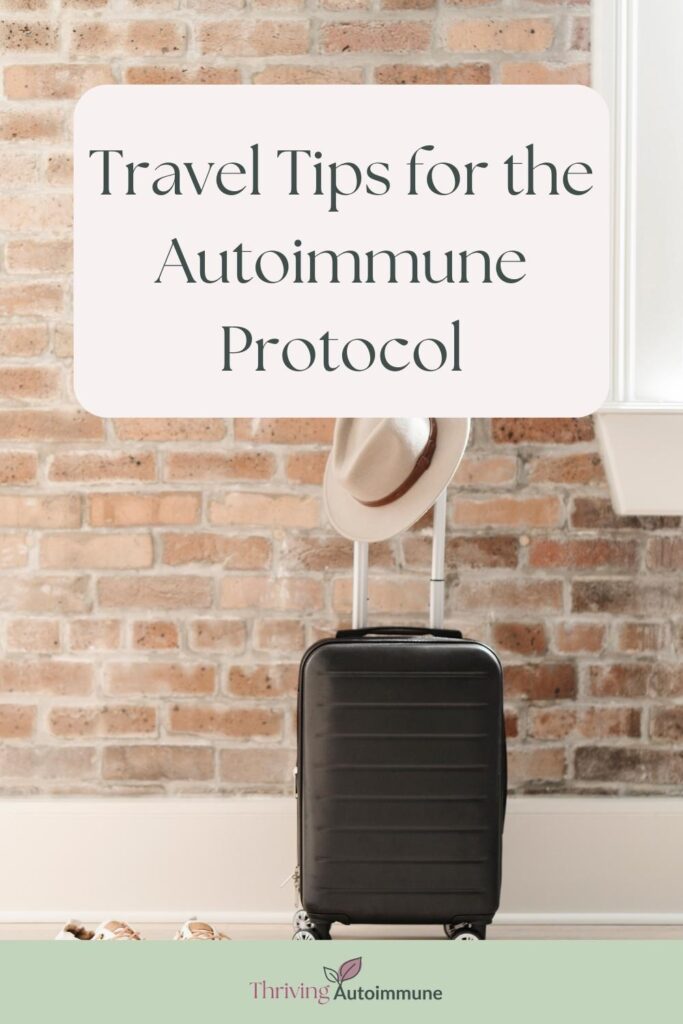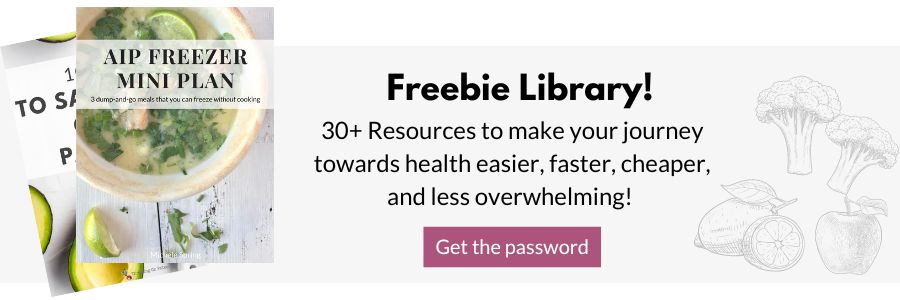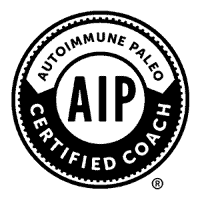This post may contain affiliate links. Please read my disclosure policy.
AIP travel (travel while on the Autoimmune Protocol) is definitely trickier than travel while not on a restricted diet, but it's not impossible. One of the big things you'll want to do to set yourself up for success is to plan as much as you can ahead of time. This is a common theme throughout AIP, but planning will give you peace of mind that you have options (and backups for those options as well).
The following are some tips for AIP Travel:
Making Your Own AIP Meals
While you may eat out on your trip (I'll have a separate post on eating out), it's a good idea to plan to prepare some meals on your own to know you'll be safe from cross-contamination and to get a variety of nutrients in.
You may choose to eat all of your own prepared meals, sometimes eat a small meal on your own before going out so that you won't make bad choices, or sometimes just have some meal options available in case eating out didn't work out as you had hoped. It's always a good idea though to have some shelf-stable snacks in your purse or briefcase (things like an Epic bar, Chomps bar, Wild Zora bar, plantains chips, coconut flakes, or dried fruit are good examples) for these situations as well.
Lodging
What type of lodging should you stay in?
When eating an AIP diet you'll have a lot more success and a lot less stress if you stay in certain types of places that will be more conducive to prepping or making meals on your own. These include hotels with kitchens, VRBOs or AirBnB's with kitchens, friends' and family's houses, and hotels with mini fridges. Hotels without mini fridges or kitchens are still possible, but you'll need to bring a cooler in order to keep any items cold.
I am a participant in the Amazon Services LLC Associates Program, an affiliate advertising program designed to provide a means for us to earn fees by linking to Amazon.com and affiliated sites.
Staying in a Hotel
Look for a hotel that has a kitchen if you can. These often have the name “Suites” in them. Call ahead to make sure you know what appliances they'll have, but typically they'll have a fridge, freezer, sink, and microwave. Sometimes they'll have a stove as well, but rarely do they have an oven.
Hotels that do not have kitchens may have a mini-fridge in the room. If they do not, sometimes you can call ahead to ask that one is put into the room.
If no fridge is available, you can bring a cooler with you and use the ice from the ice machine to keep items cold. If traveling on an airplane, a small soft-sided cooler can be packed down and stored flat when not needed.
Hotels sometimes have restaurant kitchens and if in a pinch you can ask to use their microwave or to get hot water.
What are some types of AIP meals you can eat in a hotel?
• Make a Smoothie: Bring a travel blender and some powdered collagen (these travel packets are great) and then go to a local market to get some greens, bananas or apples, and a cucumber and make a smoothie. At least you'll know you've gotten some good nutrients in for the day.
• Make a soup: Bring a mini slow cooker and cook some veggies (pre-chopped frozen broccoli, cauliflower, or butternut squash would work best here as the mini slow cookers don't cook as much as they warm) with a dried herb and salt blend from home and some bone broth overnight.
You can either buy bone broth at the market when you arrive at your destination – be sure to check labels as only a few are AIP-compliant like Pacific Foods, Epic Homestyle Chicken, and Bonafide for example – or you can use a bone broth powder. Perfect Supplements has an AIP-compliant bone broth powder that you just need to add water to, making it perfect for travel. Just reconstitute before adding to your mini slow cooker. If doing this option remember to bring a spoon and bowl to eat from.
• Make a “snack” meal: Meals don't have to actually look like normal meals you'd eat at home. Bring or buy “snack” meals that look more like a charcuterie platter than a typical meal – Epic Jerky Bars, dried fruits, coconut flakes, and olives all travel well and you can add some prosciutto, compliant-deli meats, an avocado, and some fresh fruits and veggies to round it all out.
• Make backpacking meals: I know this one sounds weird, but you can actually make complete meals – with meats/seafoods and veggies – in your dehydrator (this is the one I have) or oven that weigh practically nothing, store for years in your freezer, and reconstitute with just water.
A great resource to look at for AIP backpacking recipes is Backcountry Paleo.
Wild Zora now also has 2 flavors of AIP-compliant already-made backpacking meals if you don't want to make your own.
If doing this option, bring a heat-proof bowl and an eating utensil. Some recipes reconstitute with cold water, some don't need to be reconstituted at all (you eat them dehydrated, like jerky for instance), and some need to be reconstituted with hot water.
To reconstitute with hot water, flush out the coffee maker in your room with water (most rooms have these) and then make hot water. Sometimes the coffee makers have separate ways to get hot water to make tea as well. You can also see if the lobby or hotel restaurant has an industrial coffee maker that has a separate spigot for hot water.

Staying at an AirBnB or VRBO:
These days renting an apartment, condo, or house booked on one of these websites is quite common and available all over the world. These are a great option because typically they have full kitchens, including a stove and oven, pots, pans, and cooking utensils. If you need something like a slow cooker or Instant Pot though, you most likely will have to bring your own (easier to do when driving vs. an airplane).
TIP: Do be sure to thoroughly wash all cooking utensils, pots, and pans before using to lessen any chance of cross-contamination from non-AIP ingredients. I highly recommend you bring your own sponge to do this with so you aren't just rubbing the contaminants around on the dishes.
You can also bring your own pots, pans, and utensils if desired (usually more of an option on a road trip).
One other option for a place like this is to order from Paleo On the Go ahead of time and have it delivered to where you are staying (US only). You need to make sure you'll be able to receive the package, but then you'll have ready-made freezer meals to eat.
Staying with Family or Friends:
Staying with others also usually means access to a full kitchen.
Talk First! Before you go, have a conversation with your host/hostess and let them know that you're on a special diet. It's best to make sure you let them know you are doing this for YOU to feel better. Sometimes people feel like you're judging the way they eat, so by totally owning it (and not making any comments about the way they eat), things will go smoother.
Ask if there is a way to get a “safe space” available for you in their kitchen and fridge/freezer for you to put and prepare your food.
Tip: Ordering from Paleo on the Go could also be an option here as well, just make sure your host will have enough fridge and freezer space to accommodate the meals.
Flying on an Airplane:
Airplane and airport food is most likely out while on AIP. Some airports do have healthier options, but unless you know for sure that they'll have something you can eat, it's better to assume there will be nothing.
Sometimes you may be able to pick up some fresh fruit or a salad (but be mindful of croutons and other non-AIP ingredients and know that the dressing is most likely not compliant).
Just as in eating out, if you know of particular restaurants in an airport you can look up the menu ahead of time and see if they have anything you might be able to eat.
Do yourself a favor though and bring PLENTY of food with you in your carry-on baggage. Bring more than what you think you'll need, even if you know there is a restaurant you can eat at. Delays really can throw you for a loop, and sometimes you don't realize how hungry you'll get during your travels. It's better to have too much than not enough.
Be sure to bring both savory and sweet items to satisfy whatever mood you're in, and if your trip is long, bring a pre-packed meal or two as well.
Keep in mind that TSA regulations also prevent you from being able to bring large quantities of liquid past security, so anything you don't check needs to be solid.
Food to Bring On an Airplane or to the Airport
Some good AIP travel snacks to bring on a plane or to an airport:
• Homemade sausage patties or meatballs
• Wrap sandwiches (compliant lunch meat or prosciutto, some greens, avocado, wrapped with an AIP Flatbread, a cassava flour tortilla, AIP crepe, or coconut wrap)
• Charcuterie platter items, eaten together or just brought separately (Epic, Chomps, or Wild Zora Meat Jerky Bars, dried fruits, coconut flakes, olives, prosciutto, compliant-deli meats, an avocado, fresh fruits, and veggies)
• Snack/Bliss Balls (typically dates or figs mixed with some flavorings to form a ball) Power Balls are some premade AIP-compliant ones
• Coconut Butter Packet – these go with me everywhere, whether I'm traveling or not. They are a good dose of fat, so they keep you full for a long time, and they have a hint of sweetness which makes them a good replacement for dessert if you're trying to cut down on or stop eating sugar.
• Tigernut granola (you also can bring a bowl and a small bag of coconut milk powder. When you want to eat, mix the coconut milk powder with water in the bowl, put the granola in the bowl and eat with a spoon like cereal)
• Tigernut trail mix – sliced tigernuts, dried fruit, coconut flakes
• Homemade guac in a plastic Tupperware container and plantain chips
• A bag of pre-cut veggies like broccoli, cauliflower, carrots, or jicama
• Salad with salad dressing in a small TSA-approved bottle (put in a quart-sized plastic bag as well)
Other things to keep in mind when traveling:
You can also prepare meals before you leave and freeze them. Put them in your checked baggage in a thermal bag or soft-sided cooler if flying or into a cooler if driving.
It's a good idea if you plan on making your own meals to bring the items you may need (if your destination doesn't have them):
- a small cutting board
- knife (use a guard or put between two pieces of cardboard and wrapped with a rubber band)
- sponge
- spatula
- extra ziplock bags
- serving bowls and utensils
- herbs/spices
- salt
- small containers of avocado or olive oil (put these in a plastic bag so they don't get all over your stuff)
- any sweeteners you may want (like coconut sugar)
- the recipes you plan to make
- small travel french press (this is a french press and mug in one!) and chicory/dandelion root blend or Coffig if you want either of these coffee-alternative
Put into your checked bags if flying or a “kitchen” bag if driving.




Thank you for this! It’s hard enough for me just to make meals when I visit my mom. Next year I’m planning a 11-day overseas trip where we’ll eat lunch in sandwich-type restaurants. This gives me some tips on what to bring. The links to the travel-friendly premade food are especially helpful.